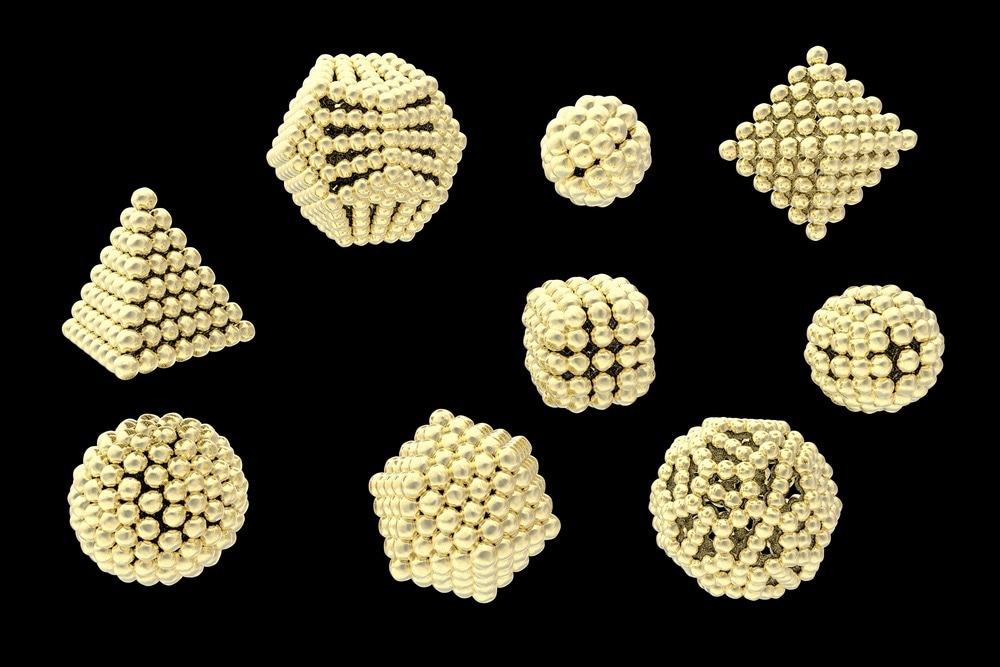Although hyperbolic phonon-polaritons were studied using near-field mapping in van der Waals crystals, their near-field signal complexity and the signal loss due to the nature of the substrate made it challenging to measure the accurate polaritonic loss.

Study: Near-field probing of image phonon-polaritons in hexagonal boron nitride on gold crystals. Image Credit: Kateryna Kon/Shutterstock.com
An article published in Science Advances demonstrated that to obtain polariton’s complex propagation constant in van der Waals crystals, it would be more feasible to use an atomically thin low-loss substrate with monocrystalline gold flakes. Here, hexagonal boron nitride (hBN) was used as an example to measure the image phonon-polaritons propagation loss.
This measurement revealed that the normalized propagation length showed a parabolic spectral dependency. Moreover, the image phonon-polaritons showed up to two-fold longer propagation length with 2.4 times more compression than the dielectric counterparts. Consequently, monocrystalline gold flakes served as a distinct nanophotonic platform to explore the low-dimensional material’s image modes.
Measurement of Polariton Dispersion
The measurement of polariton dispersion in van der Waals materials with low dimensions involves the employment of a scanning near-field optical microscope (s-SNOM). In the s-SNOM, the polariton’s excitation and detection are performed using the same nanotip. Here, the mode reflection of the material’s edge helps record the near-field interference pattern.
Moreover, in hexagonal boron nitride, the hyperbolic phonon-polaritons waves generated by the s-SNOM’s excitation beam at the hexagonal boron nitride slab’s edge contributed to the near-field signal. Furthermore, the simplification of hyperbolic phonon-polariton near-field probing is possible by facilitating the generation of polaritons from metal edges or metallic nanoparticles with larger scattering cross sections.
In the case of polariton launch, the near-field interference pattern obtained is due to s-SNOM’s quasi-uniform excitation field and the superposition of polariton fields.
On the other hand, the arbitrary shape of gold nanoparticles and their small size led to the arbitrary shape’s divergent wavefront. Thus, a nonplanar wavefront combined with a mixed near-field signal of heterogenous origin complicates the near-field analysis, calling for complex analytical models.
Previous reports mentioned the development of low dimensional polariton’s new species, supported by van der Waals crystals and placed close to the image polaritons (highly conductive metal). Here, image modes were confined to nanometer-scale volumes due to the absence of a geometry-driven cutoff.
Hexagonal boron nitride shows a distinct combination of optical properties, enabling novel nanophotonic functionalities. In the mid-IR range, the hexagonal boron nitride appears as a natural hyperbolic material, in which photonic material options are scanty. Furthermore, hexagonal boron nitride hosts defects that can be engineered to obtain room-temperature, single-photon emission; exhibits strong second-order nonlinearities with broad implications for practical devices.
Image Phonon-Polaritons in Hexagonal Boron Nitride on Gold Crystals
The present work used gold crystals with a large surface area to study the hyperbolic image phonon-polaritons (HIPs) in hexagonal boron nitride slabs by employing near-field probing. Here, long crystalline gold edges of approximately 20 micrometers were used to launch the HIP’s planar wavefront, thus, simplifying the near-field analysis.
The combined effects of the atomically thin surface of monocrystalline gold with 1 Armstrong root mean square (RMS) roughness and the crystalline structure of hexagonal boron nitride eliminated the scattering of propagating polaritons, which is generally endowed due to roughness. Thus, due to its high sensitivity, monocrystalline gold flakes can serve as ultraflat substrates for highly compressed image polaritons.
Furthermore, the physical properties of gold crystals were leveraged to measure the HIP’s complex propagation constant. The HIP’s propagation loss was extensively studied in the present work, and the obtained data were in concurrence with the calculated propagation loss in a system devoid of scattering and with less than 4% mean discrepancy.
A second-order image mode having a momentum of 5.9 × 105 centimeter inverse was detected in hexagonal boron nitride crystal with scattering-free propagation. Moreover, such high momentum was observed only in low-loss isotopically enriched hexagonal boron nitride. Finally, the investigations on near field mapping revealed that the normalized propagation length was longer, and the field confinement was stronger in the fundamental image mode than in hexagonal boron nitride on a dielectric substrate.
Conclusion
To summarize, the present work demonstrated the importance of monocrystalline gold flakes in image polariton’s precise near-field probing using hexagonal boron nitride, wherein long crystalline gold edges generated modes with planar wavefront that were propagated on a low-loss substrate that is ultraflat.
Measuring the HIP’s complex propagation constant in hexagonal boron nitride within the second band of the reststrahlen effect showed that the experimental data followed the analytical prediction for hexagonal boron nitride’s dielectric function, which was recovered independently.
Compared to hyperbolic phonon-polaritons (HPP), HIP modes in hexagonal boron nitride showed larger field confinement and longer normalized propagation, like image graphene plasmons behavior. Thus, this exceptional property permits the combined effects of light-matter interaction and wave phenomena within a hexagonal boron nitride nanophotonic platform.
Reference
Menabde, S. G., Boroviks, S., Ahn, J., Heiden, J. T., Watanabe, K., Taniguchi, T., Low, T wt al. (2022). Near-field probing of image phonon-polaritons in hexagonal boron nitride on gold crystals. Science Advances. https://www.science.org/doi/10.1126/sciadv.abn0627
Disclaimer: The views expressed here are those of the author expressed in their private capacity and do not necessarily represent the views of AZoM.com Limited T/A AZoNetwork the owner and operator of this website. This disclaimer forms part of the Terms and conditions of use of this website.